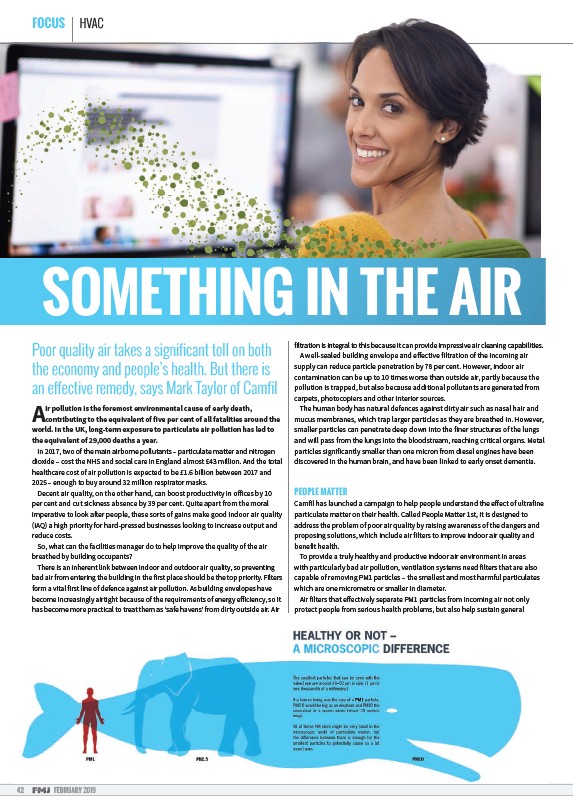
FOCUS HVAC
SOMETHING IN THE AIR
Air pollution is the foremost environmental cause of early death,
contributing to the equivalent of five per cent of all fatalities around the
world. In the UK, long-term exposure to particulate air pollution has led to
the equivalent of 29,000 deaths a year.
In 2017, two of the main airborne pollutants – particulate matter and nitrogen
dioxide – cost the NHS and social care in England almost £43 million. And the total
healthcare cost of air pollution is expected to be £1.6 billion between 2017 and
2025 – enough to buy around 32 million respirator masks.
Decent air quality, on the other hand, can boost productivity in o€ ices by 10
per cent and cut sickness absence by 39 per cent. Quite apart from the moral
imperative to look a¡ er people, these sorts of gains make good indoor air quality
(IAQ) a high priority for hard-pressed businesses looking to increase output and
reduce costs.
So, what can the facilities manager do to help improve the quality of the air
breathed by building occupants?
There is an inherent link between indoor and outdoor air quality, so preventing
bad air from entering the building in the first place should be the top priority. Filters
form a vital first line of defence against air pollution. As building envelopes have
become increasingly airtight because of the requirements of energy e€ iciency, so it
has become more practical to treat them as ‘safe havens’ from dirty outside air. Air
42 FEBRUARY 2019
filtration is integral to this because it can provide impressive air cleaning capabilities.
A well-sealed building envelope and e€ ective filtration of the incoming air
supply can reduce particle penetration by 78 per cent. However, indoor air
contamination can be up to 10 times worse than outside air, partly because the
pollution is trapped, but also because additional pollutants are generated from
carpets, photocopiers and other interior sources.
The human body has natural defences against dirty air such as nasal hair and
mucus membranes, which trap larger particles as they are breathed in. However,
smaller particles can penetrate deep down into the finer structures of the lungs
and will pass from the lungs into the bloodstream, reaching critical organs. Metal
particles significantly smaller than one micron from diesel engines have been
discovered in the human brain, and have been linked to early onset dementia.
PEOPLE MATTER
Camfil has launched a campaign to help people understand the e€ ect of ultrafine
particulate matter on their health. Called People Matter 1st, it is designed to
address the problem of poor air quality by raising awareness of the dangers and
proposing solutions, which include air filters to improve indoor air quality and
benefit health.
To provide a truly healthy and productive indoor air environment in areas
with particularly bad air pollution, ventilation systems need filters that are also
capable of removing PM1 particles – the smallest and most harmful particulates
which are one micrometre or smaller in diameter.
Air filters that e€ ectively separate PM1 particles from incoming air not only
protect people from serious health problems, but also help sustain general
Poor Tuality air takes a signifi cant toll on both
the economy and peopleƉs health. But there is
an eff ective remedy, says Mark Taylor of Camfi l